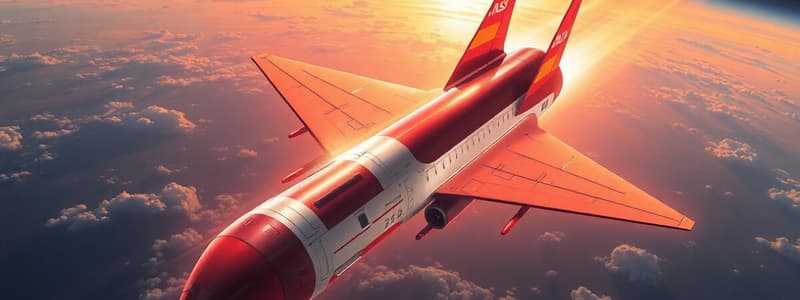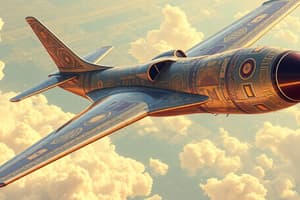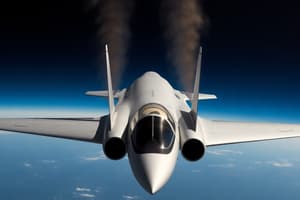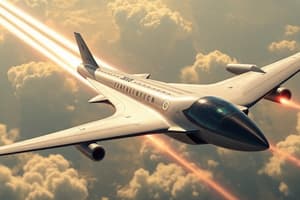Podcast
Questions and Answers
What is the primary goal of NASA's QueSST mission?
What is the primary goal of NASA's QueSST mission?
- To increase air travel speeds by a factor of three.
- To create sonic booms that are louder and more impactful.
- To develop supersonic aircraft that can fly quietly over land. (correct)
- To develop a new engine for supersonic aircraft.
Which of the following is NOT a specific design feature of the X-59 aircraft intended to minimize sonic booms?
Which of the following is NOT a specific design feature of the X-59 aircraft intended to minimize sonic booms?
- A conventional tail for low-speed stability.
- An enhanced forward vision system. (correct)
- A fixed canard for nose-up trim at low-boom design point.
- A mini T-tail that alternates shock impact.
What is the approximate speed of sound at which supersonic flight begins, according to the content?
What is the approximate speed of sound at which supersonic flight begins, according to the content?
- 680 mph (1094 km/h)
- 768 mph (1,236 km/h) (correct)
- 820 mph (1,320 km/h)
- 520 mph (837 km/h)
Which component of the X-59 is directly taken from the T-38 aircraft?
Which component of the X-59 is directly taken from the T-38 aircraft?
According to the content, what is the primary purpose of the extended nose of the X-59 aircraft?
According to the content, what is the primary purpose of the extended nose of the X-59 aircraft?
What design feature of the X-59 is primarily responsible for breaking up shock waves?
What design feature of the X-59 is primarily responsible for breaking up shock waves?
What is the expected outcome of testing the X-59 over US cities in late 2024?
What is the expected outcome of testing the X-59 over US cities in late 2024?
Why did the Concorde face limitations in its travel routes?
Why did the Concorde face limitations in its travel routes?
What innovative cockpit feature does the X-59 utilize to enhance visibility?
What innovative cockpit feature does the X-59 utilize to enhance visibility?
What is the significance of engine placement in the X-59 design?
What is the significance of engine placement in the X-59 design?
Flashcards
Supersonic Speed
Supersonic Speed
The speed of an object faster than the speed of sound, approximately 768 mph (1,236 km/h).
Sonic Boom
Sonic Boom
An intense, startling sound produced when an aircraft breaks the sound barrier. It can shake buildings and cause damage.
QueSST (Quiet SuperSonic Technology)
QueSST (Quiet SuperSonic Technology)
A NASA mission that aims to develop and test quieter supersonic aircraft.
X-59
X-59
Signup and view all the flashcards
Mini T-tail
Mini T-tail
Signup and view all the flashcards
What is the X-59?
What is the X-59?
Signup and view all the flashcards
How does the X-59's nose reduce noise?
How does the X-59's nose reduce noise?
Signup and view all the flashcards
Where is the X-59's engine located?
Where is the X-59's engine located?
Signup and view all the flashcards
What is NASA's goal with the X-59?
What is NASA's goal with the X-59?
Signup and view all the flashcards
Why was the Concorde's travel limited?
Why was the Concorde's travel limited?
Signup and view all the flashcards
Study Notes
NASA's X-59 Aircraft
- Unveiled in January 2024
- Designed to fly at supersonic speeds without the loud boom
- Innovative design for supersonic travel
- Prototype is part of the US Space Agency's Quiet Supersonic Technology (QueSST) mission
- Aims to change how supersonic travel is conducted
- The X-59 design allows it to break the sound barrier without sonic boom
- Supersonic speed is faster than the speed of sound—about 768 mph (1,236 km/h)
- When an aircraft breaks the sound barrier, it produces an intense, startling sound that can shake buildings and crack windows
- The X-59's unique features include: extended nose shape forward shock, external/enhanced forward veils system, mini T-tail, conventional tail, single-piece wing skin
- NASA plans to test the X-59 over select US cities in late 2024 to gather community feedback
- NASA hopes the data will convince officials to reconsider rules prohibiting supersonic flights over land
- If successful, the X-59 could pave the way for new commercial cargo and passenger supersonic aircraft by 2030.
Studying That Suits You
Use AI to generate personalized quizzes and flashcards to suit your learning preferences.





